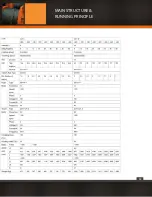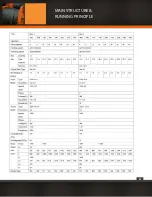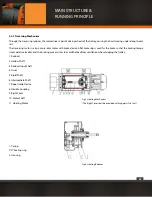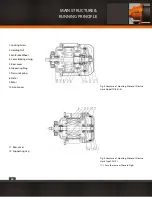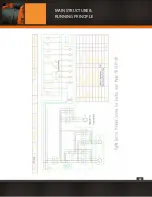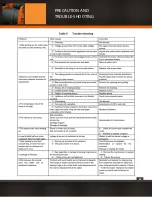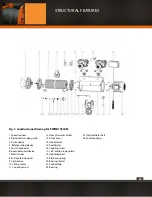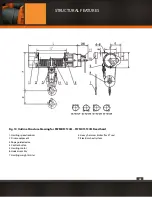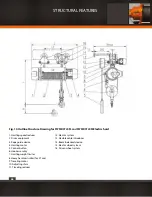
32
PRECAUTION AND
TROUBLE-SHOOTING
5 . PRECAUTION AND TROUBLE-SHOOTING
5.1 PRECAUTION
5.1.1 The electric hoist should be operated by such person who should understand the structure and properties of the hoist and be
familiar with the safety and operation regulations.
5.1.2 The space limiter is a security device for preventing the hook from exceeding the limit position when it moves up or down. It
should not be used frequently as a path switch.
5.1.3 Never suspend the load in the air long time thus may cause permanent deformation to the machine parts and other accidents.
5.1.4 After work, raise the hook two meters above the ground and cut off the main source.
5.1.5 Never lift the loads in inclination, which may damage the rope guide. Never over-load.
5.1.6 Inspect the electric hoist periodically and lubricate according to Tables 3 & 4.
5.1.7 Don’t be in panic, if any self–sliding occurs. In this case, push the button “DOWN” so that to lower the load slowly onto the
ground and check the hoist.
5.1.8 Use and Rejection of Wire Rope.
5.1.8.1 Always lubricate the wire rope well to prevent it from fast wear.
5.1.8.2 Pay attention to the fixing condition at the ends of the wire rope in the periodical inspection.
5.1.8.3 Some measures should be taken to prevent it from twist together, crisscross, be curved to folding and paste impurity on
when the wire rope is reel off the drum or rope reel.
5.1.8.4 When any condition as follows is found, the wire rope should be rejected according to GB/T5972-1986 “PRACTICAL REGULA-
TIONS OF EXAMINATION AND REJECTING FOR WIRE ROPE IN USE OF HOISTING MACHINERY”.
A) The wire rope should be rejected if the broken wires gathered in part.
B) The wire rope should be rejected if the breaking entirety happened to any strand.
C) Reject the wire rope when exterior layer of wire worn by 40% of the diameter
D) Reject the wire rope when the rope reduce 7% of the nominal diameter or more, although the broken wire is not found.
E) Reject the wire rope when the corrosion of deep pits is found or the wire is loosen.
F) Reject the wire rope immediately if any strand with basket-looking distortion is pressed out of rope or the wire rope twist together.
G) Folding is the angle deformation caused by outside influence, this rope should be rejected.
5.2 THE METHODS OF REMOVING TROUBLE
The problem and the trouble-shooting of electrical hoist should be dealt with according to the methods in the Table 5.
Summary of Contents for PWMD Series
Page 1: ...1 PWMD and PWMDF SERIES User Manual and Security Warnings...
Page 17: ...17 MAIN STRUCTURE RUNNING PRINCIPLE...
Page 18: ...18 MAIN STRUCTURE RUNNING PRINCIPLE...
Page 19: ...19 MAIN STRUCTURE RUNNING PRINCIPLE...
Page 20: ...20 MAIN STRUCTURE RUNNING PRINCIPLE...
Page 21: ...21 MAIN STRUCTURE RUNNING PRINCIPLE...
Page 22: ...22 MAIN STRUCTURE RUNNING PRINCIPLE...
Page 28: ...28 MAIN STRUCTURE RUNNING PRINCIPLE...
Page 29: ...29 MAIN STRUCTURE RUNNING PRINCIPLE...
Page 33: ...33 PRECAUTION AND TROUBLE SHOOTING...
Page 66: ...66 b PWMD3T24M TECHNICAL SPECIFICATIONS...
Page 67: ...67 c PWMD5T24M TECHNICAL SPECIFICATIONS...
Page 68: ...68 d PWMD10T24M TECHNICAL SPECIFICATIONS...
Page 69: ...69 e PWMD16T24M TECHNICAL SPECIFICATIONS...
Page 70: ...70 f PWMD20T24M TECHNICAL SPECIFICATIONS...
Page 71: ...71 g PWMD25T18M TECHNICAL SPECIFICATIONS...
Page 72: ...72 h PWMD50T12M TECHNICAL SPECIFICATIONS...
Page 73: ...73 i PWMD50T20M TECHNICAL SPECIFICATIONS...
Page 74: ...74 j PWMDF3T24M TECHNICAL SPECIFICATIONS...
Page 75: ...75 k PWMDF5T24M TECHNICAL SPECIFICATIONS...
Page 76: ...76 l PWMDF10T24M TECHNICAL SPECIFICATIONS...
Page 77: ...77 m PWMDF16T24M TECHNICAL SPECIFICATIONS...
Page 78: ...78 n PWMDF20T24M TECHNICAL SPECIFICATIONS...
Page 79: ...79 o PWMDF25T18M TECHNICAL SPECIFICATIONS...
Page 80: ...80 p PWMDF32T18M TECHNICAL SPECIFICATIONS...
Page 81: ...81 q PWMDF50T12M TECHNICAL SPECIFICATIONS...
Page 82: ...82 r PWMDF50T20M TECHNICAL SPECIFICATIONS...
Page 84: ...84...


